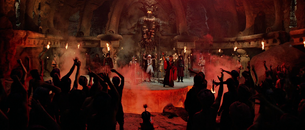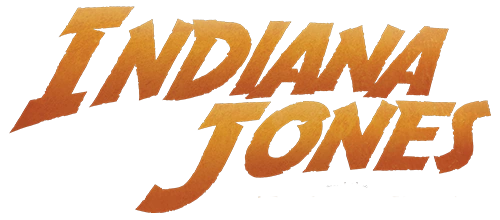- "I'm not going to have anything nice to say about this place when I get back!"
- ―Willie Scott[src]
The Temple of Doom was a place of worship to the goddess Kali. Used by the Thuggee cult, the temple was built deep underground beneath Pankot Palace in India.
History
The main temple room was divided by a chasm filled with lava below. Worshippers and musicians would stay on the main side of the room, while focusing their attention on the activity on the other side of the chasm.
At the center of the smaller side of the temple, stood a large statue of Kali, and an altar in the shape of a skull that housed the Sankara Stones. In front of the statue was a portal in the ground, which lead to a volcanic vent. Human sacrifices could be lowered in a cage into the vent. Statues around the chamber dated back to the fifteenth century, and included one of Ganesha.

The Temple of Doom during a sacrifice ritual
By 1935, Mola Ram had revived the Thuggee cult, and was using the underground temple for rituals. Below the temple were mines where the enslaved children of Mayapore labored to find the last two Sankara stones for Mola Ram.
After an assassination attempt in Pankot Palace, Indiana Jones, Short Round and Willie Scott discovered the trap-filled chambers that led from Scott's room to the caves beneath the palace, where they found the Temple. They watched in horror as Mola Ram magically removed the heart of a Sacrifice Victim then lowered the still-living man into the lava pit, while many worshipers, including Zalim Singh watched and chanted. After the ceremony, Jones climbed down to try to claim the Sankara Stones, and discovered a vent leading into the mines. Meanwhile, Short Round and Scott were captured. Jones was also captured, and forced to drink the Black Sleep of the Kali Ma, turning him into a pawn of the Thuggee. Mola Ram started a new ceremony, using Willie Scott as the sacrifice victim, and made Jones assist him. Short Round used fire to break the Thuggee hold on Jones, and the two freed Scott from the cage and fought off Thuggee acolytes and Chattar Lal. Before Jones could get Mola Ram, the high priest escaped through a secret passage below the statue of Kali. Jones, Short Round, and Scott went into the mines to free the children, and shut down the Thuggee operation. After the Chief Guard was defeated, and Zalim Singh was freed of Thuggee influence, Jones and his companions fled in mine cars, and outracing a flood caused by the collapse of a large cistern, found an exit on the face of the cliff.[1]
Aftermath
Following Lal's escape from Pankot Palace with a large amount of stolen treasure, the British decided to keep an eye out in case Lal tried to establish another Kali temple.[2]
Although Mola Ram was killed by crocodiles in the encounter at Pankot's bridge, stories circulated that Ram haunted the ruins of the Temple of Doom, rumors that Zalim Singh and the British didn't attempt to disuade as they were keen to keep others away from the area.[3]
Behind the scenes
Why Indiana Jones and his friends decide to use the mines for their escape rather than using the same route through which the Mayapore children took to escape goes unexplained in Indiana Jones and the Temple of Doom. There was intended to be a scene in the film where Indy used a large wooden plank as a bridge so that the slave children could cross the lava to the other side of the temple and escape via the tunnel that connects to Willie Scott's Pankot Palace bedroom. However, when it is Shorty's turn to cross, the plank breaks apart from the heat of the lava, and Willie and Indy catch him from falling. This forces the trio to use the mines as an alternative escape route. While the scene was indeed filmed, it was cut from the final edit.[4]
It should be noted that during the mine cart chase, when Indy's party and the Thuggee travel through different tunnels in the mine carts, several chasms are visible. However, when Mola Ram floods the tunnels, the water quickly reaches them with little difficulty.
Appearances
- The Day of Destiny (Mentioned only)
- Indiana Jones and the Temple of Doom (First appearance)
- Indiana Jones and the Temple of Doom novel
- Indiana Jones and the Temple of Doom comic
- Indiana Jones and the Temple of Doom junior novel
Sources
- Indiana Jones and the Temple of Doom TSR
- Indiana Jones and the Temple of Doom Sourcebook
- Indiana Jones: The Ultimate Guide
